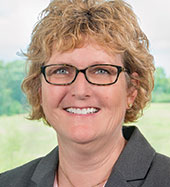
By Fred Orlip
The Scene staff
Forest Park students, many of whom have been taking classes online since mid-March because of the coronavirus pandemic, can expect to be back on campus when the fall semester begins Aug. 24.
But the issue of how many students and for what classes is still being hashed out — a monumental task that has involved analyzing more than 3,000 classes.
“We, I think, are getting much closer,” campus President Julie Fickas told The Scene on Thursday. “Entering things into the system have been just a little bit slower than we anticipated, but we’ve been working very quickly now, so I anticipate what we’ll see is sometime in the next week or two that everything will be completed.”
Returning students will be required to follow coronavirus-related safety protocols being put in place, including the mandatory wearing of face coverings.
Though the class schedule is still being tweaked, Fickas said students can go ahead and enroll.
Fickas is co-chairing a St. Louis Community College committee called FAST — the Fall Academic Affairs Safety Team — made up of nearly two dozen STLCC administrators, faculty members and students charged with making recommendations on how to proceed in the midst of the deadly pandemic that has infected more than 2.7 million people in the United States and killed nearly 130,000.
Safety is the college’s top priority, Fickas said, and with limited capacity in some classrooms, adjustments are being made to deal with those limitations. Classes that normally take place in small rooms on campus “were put into more of an online format, where the capacity could be bigger,” she said.
“All of this had to happen because students had already enrolled in these classes, and when you do those kinds of schedule changes, you have to be careful that you don’t mess up things in the system for them,” Fickas said. “There’s a lot of maneuvering of student and student data that has to happen behind the scenes.”
Because so many changes to the class schedule were required, the team canceled some sections and built new ones.
“It’s not a one-for-one switch, and that’s where there were a lot of issues,” Fickas said. “But there couldn’t be because of the very nature of what we’re needing to do. So it’s been quite complex. People have been working through their weekends, day and night, to try to make this as easy as possible.”
Administrators have kept an eye on the pandemic case count and reviewed various scenarios from epidemiologists, leading FAST to embrace a flexible class schedule.
“Even those classes that will be on campus or have some on-campus portions to them will have a notation that says this class could move to a fully online format at any time,” Fickas said. “Just to have that flexibility that we don’t have to leave students behind. There are some classes we can’t do that. You can’t learn to be a respiratory therapist using a ventilator if you don’t have a ventilator.”
Fickas said she didn’t have an estimate on how many students will be able to study on campus this fall, focusing instead on those who have more need for face-to-face engagement. They might get hybrid-style classes that include both on-campus and online learning.
Those classes include English as a second language, some development education courses and math, Fickas said. The college’s general transfer program is among the most popular, and those students will have some morning, afternoon and evening classes.
The college has created a new degree program, an associate of science in STEM, which will be offered in a daytime format.
Fickas stressed the importance of students, faculty and staff wearing face coverings.
“The only way we can offer these things on campus is to make sure that we’re being safe for everyone,” she said. “We’ve got to do it for the good for all.”
FAST is working on more ideas for students, “but we haven’t firmed them up yet,” Fickas said, noting the team has two student participants “who were very vocal, and they were incredibly helpful in the process in helping us getting through things.”
